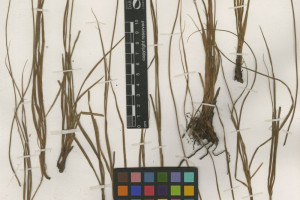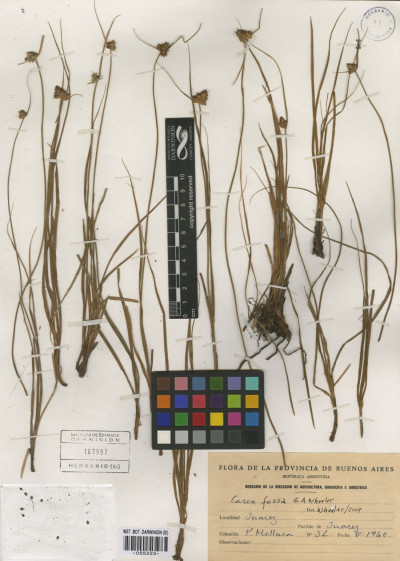Descripcion
Distribucion y Habitat
Distribution: Argentina, at least from Buenos Aires and Pampa, south to Chubut, other records north of the indicated area in Argentina, Paraguay, Uruguay and Brazil are here considered doubtful (see notes below) [84 BZS? 85 AGE AGS AGW? PAR? URU].
Sinónimos
Carex fossa G.A. Wheeler
Bibliografía
Ejemplares de referencia
| Colector | N° Colect. | Especie | Departamento | Provincia | Imagen |
|---|---|---|---|---|---|
|
|
161 | Buenos Aires |

|
||
|
|
276 | San Isidro | Buenos Aires |

|
|
|
|
-1 | 19 | Buenos Aires | ||
|
|
-1 | (SI 198854) | Tornquist | Buenos Aires |

|
|
|
-1 | (SI 2357) | Tornquist | Buenos Aires |

|
|
|
21366 | General Roca | Córdoba |

|
|
|
|
1568 | Andalgalá | Catamarca |

|
|
|
|
232 | CORD116511 | Buenos Aires |

|
|
|
|
612 | CORD116514 | Uruguay | Entre Ríos |

|
|
|
678 | Rio Grande do Sul |

|
||
|
|
22 | SMB15 | Saavedra | Buenos Aires |

|
|
|
32 | Benito Juárez | Buenos Aires | ||
|
|
3303 | Soriano |

|
||
|
|
7376 | Pergamino | Buenos Aires |

|
|
|
|
172 | - |

|
||
|
|
99322 | Tornquist | Buenos Aires |

|
|
|
|
1933 | La Pampa |

|
||
|
|
5274 | Dolores | Buenos Aires |

|
Nombre Vulgar y Usos
Tipo y Observaciones
Material Tipo: Nom. nov. para Carex involucrata Boott, nom. illeg., non Carex involucrata Boeckeler (1855).
Observaciones: Iconography: Figures 1C, 2E, 3E. Additional figures
in Boott (1858–1867: tabs. 209–2010, as Carex
involucrata) and Barros (1935: 202, as C. sororia?).
Etymology: From the Latin fossa, literally, ditch or pit,
a term chosen by Wheeler (2002) to refer to the ‘weedy’
habitat of this species, often occurring in roadside
verges, ditches or along railroad embankments.
Notes: The illegitimate name Carex involucrata Boott
remained in synonymy under C. sororia until Wheeler
(2002) resurrected the taxon with the new name C.fossa.
He presented a putative combination of characters
including utricles and inflorescences distinctive of
C. fossa and reported the species as occurring from the
Argentinian Patagonia north to Salta, Paraguay and
Uruguay. Wheeler did not study any actual voucher
from the northern areas, and he entirely relied on
bibliographic records reporting C. involucrata from
there. He also mentioned a doubtful entity from
northern Argentina and southern Brazil, C. sororia var.
pseudobracteosa (Kük.) Kük., somehow intermediate
between what he considered C. fossa and C. sororia. We
have studied vouchers identified by Wheeler as C. fossa
from the entire area, including Paraguay, Uruguay and
Brazil. Whereas the specimens from the southern half
of the range seems to us to be more or less constant and
distinct from C. sororia, we agree with Wheeler that
the delimitation of C. fossa becomes much problematic
in the northern part of



